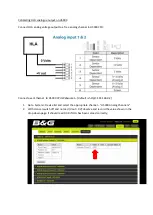
13
BELT OFFSET TO THE RIGHT.-
This procedure is very important. Follow these steps. In
order to adjust the belt, set the unit in motion at a speed of
4km/h.
If the belt has moved to the right, turn screw (R) on the
right-hand side of the machine
a 1⁄4 turn clockwise. Note
the position of the belt, if after one minute the belt is not
completely centred then repeat the operation. If you see
that the belt has moved too far over to the left then turn
the right screw back slightly in an anticlockwise direction
Fig.9.
As soon as you have adjusted the belt you can begin
exercising again.
BELT OFFSET TO THE LEFT.-
In the event that the belt has moved to the left, turn screw
(L) on the left-hand sid
e of the machine a 1⁄4 turn
clockwise. Note the position of the belt, if after one minute
the belt is not completely centred then repeat the
operation. If you see that the belt has moved too far over
to the right then turn the left screw back slightly in an
anticlockwise direction Fig.9.
Important: Overtightening of the belt can lead to a loss of
speed on the machine and even stretch the belt itself.
Bear In mind that one turn of the right screw (R) in a
clockwise direction has the same effect on the position of
the belt as one turn of the left screw (L) in an
anticlockwise direction. Consequently, in the event of
excessive belt movement you can use either of the two
screws in order to avoid overtightening the belt.
OPERATING INSTRUCTIONS.-
FITNESS.
Being fit means living life to the full. Modern society
suffers greatly from stress. City life is basically sedentary.
There are too many calories and too much fat in our diet.
All doctors agree that regular exercise is a good way to
control our weight, make us fitter and help us to relax.
ADVANTAGES OF EXERCISE.-
Regular exercise below a certain level for 15/20 minutes
becomes aerobic. Aerobic exercise is basically exercise
that uses oxygen. Normally, this is a continuous exercise
without pauses. In addition to sugars and fats, the body
also needs oxygen. Regular
exercise improves the body’s
ability to supply oxygen to all of the muscles and at the
same time improve lung function, the heart’s pumping
capacity and better blood circulation. In short, the energy
produced during exercise burns kilocalories (known as
calories).
EXERCISE & WEIGHT CONTROL.-
The food we eat is transformed into, among other things,
energy (calories) for our body. If we take in more calories
than we burn then the result is an increase in weight and
vice versa, if we burn more calories than we eat, we lose
weight. When resting the body burns around 70 calories
per hour to keep our vital functions active.
MONITOR THE HEART BEAT.-
The body’s work rate is reflected by the rate of the heart
beat (pulsations) which increases as the work rate
increases. The effort in your treadmill depends on the
speed. If you increase the speed, the work rate and the
heart rate increase too. If the work rate maintains
constant, the heart rate increases up to a point where no
matter how much work increases the heart does not beat
any faster. This is known as the maximum heart rate and it
decrease with age. A familiar formula for calculating this
maximum heart rate, where exhaustion sets in, is 22
minus age.
Exercising should be carried out at between 65% to 85%
of the maximum heart rate for 15-20 mins and it is
recommentded that is should not exceed 85%.
Example: 50 years old
220-50=170 puls
Heart rate
Pulsations
Maximum
170
85%
144
Aerobic zone
75%
127
65%
112
EXERCISE PROGRAM.-
Before starting any exercise program, bearing in mind that
exercise programs vary depending on age and physical
condition, it is advisable to consult your doctor given that
you will achieve better results based on his/her advice or
suggestions. Regardless of whether your goal is to
become fitter, control your weight or for physiotherapy,
always remember that your exercise should be gradual,
planned, varied and not too demanding. We recommend
that you should exercise 3 to 5 times per week.
Before beginning a session it is important to do a warm-up
for 2-3 minutes at low speed. This will help protect your
muscles and prepare your cardiorespiratory system.
The next stage will last 15-20 minutes at a pulse rate of
between 65 to 75%, or between 75 to 85% for those
already accustomed to exercise. At a later stage, once we
have become fitter, we can divide this time between both
levels but always remembering that the pulse rate must
not exceed 85% (aerobic area) and never reach the
maximum heart rate limit that corresponds to our age.
We you have finished, it is important to relax the muscles.
This can be done by walking at a low speed for 2-3
minutes until the heart rate drops below the 65% line.
This will prevent muscle pain, especially after an intense
session. It is also advisable to finish the program with
some relaxation exercises on the floor.
Summary of Contents for 3265707
Page 2: ...2 Fig 0 ...
Page 3: ...3 Fig 1 Fig 2 ...
Page 4: ...4 Fig 3 Fig 4 ...
Page 5: ...5 Fig 5 Fig 6 Fig 7 Fig 8 Fig 9 ...
Page 41: ...G688BM ...














































